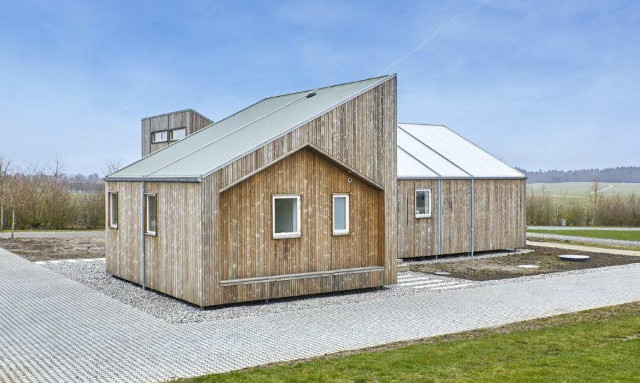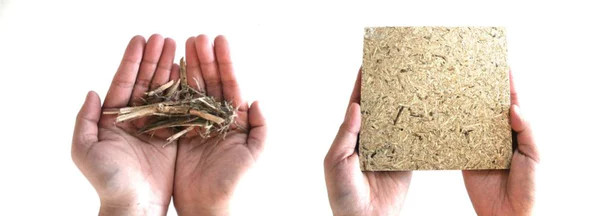The world's first biologist was built from agricultural waste
This bizarre biologist was created by a multidisciplinary scientific group of more than 40 partners, including design firm Een TIl Een, sustainable architecture firm GXN, Kebony wood processing company and the Ministry of Environment. Denmark.
To begin, GXN cooperates with partners from the Danish livestock industry to collect biological materials such as grass, straw, tomatoes and seaweed. They are then combined into composite materials to maximize their strength and squeeze into paving boards.

Kebony expert then treated softwood by applying heat and liquid based on biological treatment mechanism. This makes the polymerizes molecules constitute the cell inside the wooden material, making it carry the characteristics of tropical hardwood along with dark brown brown, developing a silvery-gray patina layer after sun exposure.

The implementation of the above operation was checked by the Danish Institute of Technology, and monitored in its powers, helping to create a structure that could compete with the power of other conventional homes.

Not only that, this biologist is on a screw-anchored earth anchor system, not a foundation made of concrete, a material with a high carbon content.
Above all, the house is modularly designed, which means it can be tailored to meet customer needs, installed quickly and then disassembled without leaving any trace. at all.
See more:
- Examine the process of turning garbage into street bricks and clothes in Japan
- How long does it take waste to decompose?
You should read it
- Manufacturing electric cables from plastic waste - The great plan for the situation of plastic waste pollution in the world today
- While many countries are 'flooded with garbage', the country is importing waste to use
- Chemical recycling can be a solution to the problem of plastic waste pollution
- Dubai builds the world's largest waste-to-electricity recycling plant
- How are people using plastic to destroy nature?
- Why do humans not bring waste to the Sun?
- Turn human waste into cheap coal for human daily life
- Picking up marine waste sorted into impressive works
May be interested
- Ni no Kuni: Cross Worlds - How to turn off auto-battle and auto-play
 ni no kuni: cross worlds is a comprehensive multiplayer role-playing game from developer level-5, with cutscenes made by studio ghibli, the renowned animation studio that has made iconic films such as my neighbor totoro and spirited away.
ni no kuni: cross worlds is a comprehensive multiplayer role-playing game from developer level-5, with cutscenes made by studio ghibli, the renowned animation studio that has made iconic films such as my neighbor totoro and spirited away. - Review : The Outer Worlds - Peril On Gorgon DLC- Your choices make you who you are
 once again experience the sci-fi life through the outer worlds - peril on gorgon dlc after an 11-month absence.
once again experience the sci-fi life through the outer worlds - peril on gorgon dlc after an 11-month absence. - Surprising truth about non-recyclable items
 want to improve your waste sorting skills? read on to learn what you can't recycle and what you can do with it.
want to improve your waste sorting skills? read on to learn what you can't recycle and what you can do with it. - Picking up marine waste sorted into impressive works
 impressive works from plastic waste from the sea by artist barry rosenthal, to appeal to people to protect the environment, especially the marine ocean environment.
impressive works from plastic waste from the sea by artist barry rosenthal, to appeal to people to protect the environment, especially the marine ocean environment. - Examine the process of turning garbage into street bricks and clothes in Japan
 visit one of the modern waste treatment plants in tokyo to know how effective japanese waste disposal is!
visit one of the modern waste treatment plants in tokyo to know how effective japanese waste disposal is! - Why do we throw waste into volcanoes to handle?
 active volcanoes filled with lava with temperatures of about 700 ° c to 1,200 ° c. with this temperature, it can burn everything like a natural incinerator. so why don't we use volcanoes to destroy garbage?
active volcanoes filled with lava with temperatures of about 700 ° c to 1,200 ° c. with this temperature, it can burn everything like a natural incinerator. so why don't we use volcanoes to destroy garbage? - Ni no Kuni: Cross Worlds - Location of treasure chests in Golden Grove
 ni no kuni: cross worlds is a new mobile game that takes many familiar elements from other mmorpgs but adds features from level-5's ni no kuni series.
ni no kuni: cross worlds is a new mobile game that takes many familiar elements from other mmorpgs but adds features from level-5's ni no kuni series. - Discover the process of turning wastewater into beer in the United States
 this process is capable of handling 30 million liters of wastewater per day for beer production
this process is capable of handling 30 million liters of wastewater per day for beer production - Ni no Kuni: Cross Worlds tips for beginners
 ni no kuni: cross worlds tips for beginners, helpful tips for beginners when diving into the world of ni no kuni: cross worlds - adventure game
ni no kuni: cross worlds tips for beginners, helpful tips for beginners when diving into the world of ni no kuni: cross worlds - adventure game - Manufacturing electric cables from plastic waste - The great plan for the situation of plastic waste pollution in the world today
 treating plastic waste is one of the most urgent problems worldwide.
treating plastic waste is one of the most urgent problems worldwide.










 The source of biofuels from coffee can be used to operate buses
The source of biofuels from coffee can be used to operate buses Electric eel - inspired to create biocompatible hydrogel batteries
Electric eel - inspired to create biocompatible hydrogel batteries 6 million people in the US are using water that contains toxic chemicals
6 million people in the US are using water that contains toxic chemicals Advanced anti-pollution mask launched in India
Advanced anti-pollution mask launched in India Warning about air pollution levels: Find magnetic waste in the human brain
Warning about air pollution levels: Find magnetic waste in the human brain While many countries are 'flooded with garbage', the country is importing waste to use
While many countries are 'flooded with garbage', the country is importing waste to use